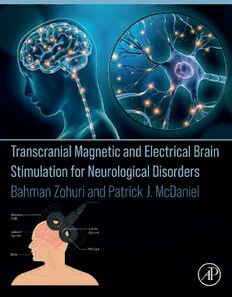
Transcranial Magnetic and Electrical Brain Stimulation for Neurological Disorders PDF
Preview Transcranial Magnetic and Electrical Brain Stimulation for Neurological Disorders
TRANSCRANIAL MAGNETIC AND ELECTRICAL BRAIN STIMULATION FOR NEUROLOGICAL DISORDERS This page intentionally left blank TRANSCRANIAL MAGNETIC AND ELECTRICAL BRAIN STIMULATION FOR NEUROLOGICAL DISORDERS Bahman Zohuri ArtificialIntelligenceScientistatGoldenGateUniversity,SanFrancisco,CA,UnitedStates;AgenoSchoolofBusiness,ArtificialIntelligence,San Francisco, CA, UnitedStates Patrick McDaniel Department ofNuclear Engineering,University ofNew Mexico,Albuquerque, NM,UnitedStates AcademicPressisanimprintofElsevier 125LondonWall,LondonEC2Y5AS,UnitedKingdom 525BStreet,Suite1650,SanDiego,CA92101,UnitedStates 50HampshireStreet,5thFloor,Cambridge,MA02139,UnitedStates TheBoulevard,LangfordLane,Kidlington,OxfordOX51GB,UnitedKingdom Copyright©2022ElsevierInc.Allrightsreserved. Nopartofthispublicationmaybereproducedortransmittedinanyformorbyanymeans,electronicormechanical,including photocopying,recording,oranyinformationstorageandretrievalsystem,withoutpermissioninwritingfromthepublisher.Details onhowtoseekpermission,furtherinformationaboutthePublisher’spermissionspoliciesandourarrangementswithorganizations suchastheCopyrightClearanceCenterandtheCopyrightLicensingAgency,canbefoundatourwebsite:www.elsevier.com/ permissions. ThisbookandtheindividualcontributionscontainedinitareprotectedundercopyrightbythePublisher(otherthanasmaybenoted herein). Notices Knowledgeandbestpracticeinthisfieldareconstantlychanging.Asnewresearchandexperiencebroadenourunderstanding, changesinresearchmethods,professionalpractices,ormedicaltreatmentmaybecomenecessary. Practitionersandresearchersmustalwaysrelyontheirownexperienceandknowledgeinevaluatingandusinganyinformation, methods,compounds,orexperimentsdescribedherein.Inusingsuchinformationormethodstheyshouldbemindfuloftheirown safetyandthesafetyofothers,includingpartiesforwhomtheyhaveaprofessionalresponsibility. Tothefullestextentofthelaw,neitherthePublishernortheauthors,contributors,oreditors,assumeanyliabilityforanyinjuryand/ ordamagetopersonsorpropertyasamatterofproductsliability,negligenceorotherwise,orfromanyuseoroperationofany methods,products,instructions,orideascontainedinthematerialherein. ISBN:978-0-323-95416-7 ForinformationonallAcademicPresspublicationsvisitour websiteathttps://www.elsevier.com/books-and-journals Publisher:NikkiP.Levy AcquisitionsEditor:AnnaValutkevich EditorialProjectManager:CzarinaMaeS.Osuyos ProductionProjectManager:MariaBernard CoverDesigner:MatthewLimbert TypesetbyTNQTechnologies Dedication This book is dedicated to my son Sasha. Bahman Zohuri This book is dedicated to my sons Peter and Philip. Patrick J. McDaniel v This page intentionally left blank Contents About the authors xi Preface xiii Acknowledgment xvii 1. Foundation of electromagnetic theory 1.1 Introduction 1 1.2 Vector analysis 1 1.3 Further developments 11 1.4 Electrostatics 13 1.5 Solution ofelectrostatics problems 19 1.6 Electrostatics energy 20 1.7 Mx’sequations 25 1.8 The Law ofBiot and Savart 26 1.9 The lorentz transformation 29 1.10 Electric field of amovingcharge 31 1.11 Interaction between two moving charges 34 1.12 Elementary applications ofthe Biot and Savart Law 36 1.13 A’s law 45 1.14 Scalar and vector potentials 53 1.15 Hall effect 57 References 59 2. All about wave equations 2.1 Introduction 61 2.2 The classical wave equationand separation of variables 63 2.3 Standing waves 67 2.4 Seiche wave 68 2.5 Underwater orinternal waves 71 2.6 Maxwell’sequations and electromagnetic waves 72 2.7 Scalar and vector potentials 77 2.8 Gaugetransformations, Lorentzgauge, and Coulombgauge 79 2.9 Infrastructure,characteristic, derivation,and properties ofscalar waves 81 2.10 The quantum waves 163 2.11 The X-waves 167 2.12 The nonlinear X-waves 171 2.13 The bessel’s waves 172 2.14 Generalized solution to wave equation 174 References 179 Further reading 181 3. Computational neuroscience and compartmental modeling 3.1 Introduction 183 3.2 Fuzzylogic and neural networks 184 3.3 Rise of machines,artificialsuper-intelligence 185 3.4 Fundamentalissues ofartificial intelligence 187 3.5 Ethicsofbig andsmallof artificial intelligence 188 vii viii Contents 3.6 Brian, aneuralwet computer 189 3.7 The computational theoryof mind 190 3.8 Artificial intelligence 192 3.9 What is intelligence? 192 3.10 The cognitive modelingapproach driven byhuman thinking 194 3.11 Type of artificial intelligence 195 3.12 Example of artificial intelligence technology 196 3.13 Artificial intelligence applications 197 3.14 The artificial intelligence: the road tosuperintelligence 197 3.15 The rise ofartificial intelligenceand itsthreat to humanity 200 3.16 Neurons and brain cells 203 3.17 Type of neurons 204 3.18 Neuroscience, and brains processing information 206 3.19 Neural networks 207 3.20 The classicalcomputational theory ofmind 208 3.21 Computational neuroscience 209 3.22 Embodied cognition 210 3.23 Onthe nature ofcognition 210 3.24 Modelingneurons 211 3.25 Equivalentcircuitofa single compartment 213 3.26 Axonal connections,synapses, and networks 215 3.27 Simulation accuracy 216 References 217 Further reading 219 4. The impact of technology on mental health 4.1 Introduction 221 4.2 The impact ofmoderntechnology on mental health 222 4.3 Is social media ruining your social life? 227 4.4 Social media use and depressionlinkedin large study 228 4.5 Physicians: can social media makeor break your career? 228 4.6 Generation stress: the mental health crisis on campus 230 4.7 Howcan we overcomeloneliness? 233 4.8 Common disorders 234 4.9 Mooddisorders 235 4.10 Early signsofdepression 235 4.11 Treatments 236 4.12 Cognitive behavioraltherapy 236 4.13 Prevalenceofanymental illness 238 4.14 Electricalbrain stimulation totreat neurological disorder 242 References 248 Further reading 249 5. Sleep driving improvement of declarative memory 5.1 Introduction 251 5.2 Enhancing long-term memory 252 5.3 Different sleep stages for memory formation 253 5.4 Reactivation ofnewly formed memoriesduring sleep 254 5.5 Electrophysiological signs: spindle activity, direct current potentials, and slow oscillations 255 5.6 Acetylcholine, aneurotransmitter regulating sleep andmemory 258 5.7 Electrosleepda clinical trail approach 259 5.8 Conclusion 261 References 264 ix Contents 6. Electrical brain stimulation to treat neurological disorders 6.1 Introduction 267 6.2 Abrief history 267 6.3 Recently emerging methods 269 6.4 Applications 299 6.5 Conclusions 301 References 301 7. Brain stimulation therapies 7.1 Introduction 303 7.2 Abetter approach totherapy 304 7.3 Physical and mathematical backgroundand technicalcharacteristicofTMS 306 7.4 TMS procedure description and maindefinitions 309 7.5 Cortical excitability studies 310 7.6 Neuronal plasticity studies 311 7.7 Effect of electric fieldson individual neurons 311 7.8 Interaction ofnetwork oscillations and electric fields 312 7.9 Computational neuralmodels 313 7.10 Effectsofweakelectric fields on the human brain 313 7.11 Electric fields future directions 314 References 314 Further reading 316 8. Artificial intelligence driven by machine learning & deep learning 8.1 Introduction 317 8.2 History ofartificialintelligence 318 8.3 Weak artificial intelligence (WAI) 319 8.4 Artificial general intelligence (AGI) 322 8.5 Naturallanguage processing (NLP) 324 8.6 Cognitive science andcognitive linguistics 327 8.7 Big data 328 8.8 Summaryand conclusion 333 References 333 9. Artificial Intelligenceedriven mental health and depression treatment 9.1 Introduction 335 9.2 Depression basics 337 9.3 What are the signs and symptoms of depression? 338 9.4 Artificial Intelligence and Optical Character Recognition 339 9.5 Conclusion 340 References 341 10. Global suicide rate among youngsters increasing significantly 10.1 Introduction 343 10.2 Who is at risk for suicide and why? 345 10.3 What are the warning signs for suicide? 347 10.4 The impact of modern technology on mental health? 349 10.5 Transcranial magneticstimulation driving depressiontreatment 351 10.6 Transcranial alternating current stimulation 352
